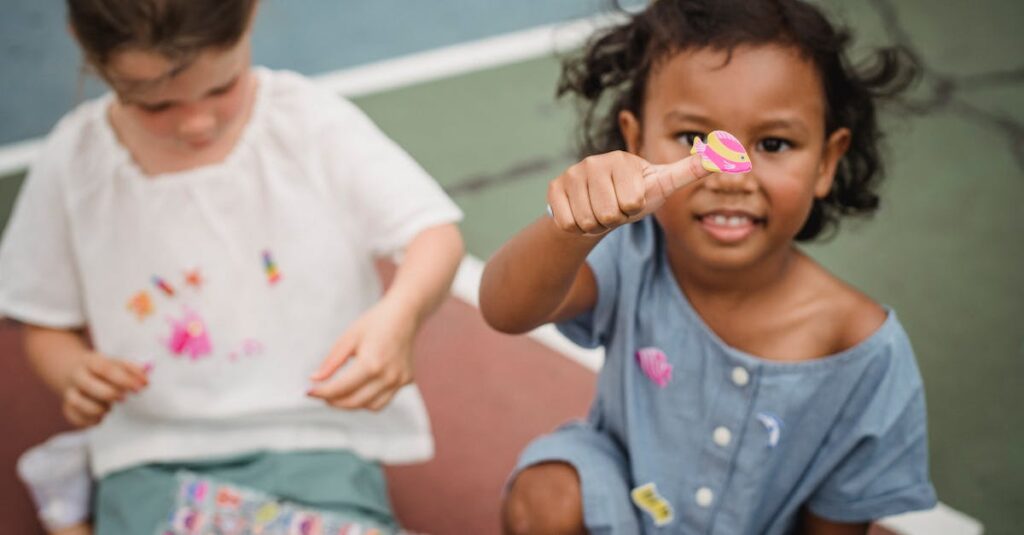The Magic of Puppets
Puppets have a unique ability to capture the imagination of preschoolers. These magical characters can transform simple lessons into unforgettable adventures. Children see puppets as friends, not just toys.
By creating stories of mishaps and resolutions, you can teach forgiveness effectively. Imagine a puppet knocking over another puppet’s block tower! Through the storyline, guide kids to understand the impact and how to make amends.
Using puppets, forgiving becomes less of a task and more of an engaging narrative. Try using a range of puppet characters to address different situations. Each has its storytelling flair, making the lesson diverse and relatable.
Remember, in the world of preschoolers, it’s Shaun the Sheep, not a stuffed animal, who makes a fashion statement.
Role-Playing Scenarios
Role-playing mimics real-life scenarios but provides a safe space for learning and making mistakes. Consider setting up a pretend tea party where an ‘accidental’ spill occurs. Guide kids to navigate the aftermath by encouraging apologies and accepting them. This ensures they understand diverse perspectives and the emotions involved in forgiveness.
Each scenario plays out like a fun movie, minus the popcorn. Encourage them to play various roles, mixing responsibilities. Perhaps let your child be the one who forgives this time around.
Role-playing helps children experiment with empathetic responses and behavioral choices that lead to emotional growth. In essence, it’s like giving them a toolbox where forgiveness is a bright, shiny hammer, ready to construct friendship bridges.
Forgiveness: A Crucial Skill
Forgiveness is not just a ‘nice-to-have’ skill but a necessity in a preschooler’s development. Imagine the playground as a budding arena of social dynamics. Here, without forgiveness, every quarrel could turn into a Shakespearean drama.
Teaching forgiveness helps maintain harmony and understanding, making kids feel comfortable in their interactions. Plus, it decreases conflict, creating a more joyful learning environment.
The Role of Parents
As parents, leading by example is crucial. If your child sees you forgiving, they mimic those actions. Make forgiveness a part of everyday life, akin to brushing teeth or bedtime stories. It’s all about reinforcing the essence of ‘let’s make up!’
Learning Forgiveness
Preschoolers need simplicity and consistency in learning forgiveness, just as in learning shapes or colors.
Overcoming Common Emotional Hurdles
Preschoolers often struggle with understanding emotions and how to process them. Imagine if every sad toddler turned into a brooding artist! Making mistakes is a part of the learning curve. However, some kids might find it difficult to forgive or move past conflicts.
Addressing Emotional Challenges
To tackle these challenges, it is crucial to communicate openly. Here are some strategies:
- Ask questions: Inquire how they feel when someone apologizes sincerely.
- Positive reinforcement: Offer encouragement when they practice forgiveness effectively.
- Normalize mistakes: Highlight that everyone makes mistakes.
- Mix humor with honesty: This approach allows children to internalize emotional growth subtly.
Creating an Environment of Empathy
Coloring the world with empathy is our job! Use cheerful language, and remember:
- Kids bounce back quickly when they feel supported and understood.
- Keep forgiveness a normal conversation; don’t make it a lecture.
By fostering an open dialogue and a supportive environment, we can help preschoolers navigate their emotional hurdles more effectively.
Engage with Laughter and Empathy
Children learn best when they are having fun. Inject some humor and laughter into forgiveness lessons. Remember, your family is the comedic audience of your teaching sitcom.
- Make silly, exaggerated scenarios where a puppet keeps spilling the juice.
- Provide forgiveness lessons amidst giggles and chuckles.
This approach makes the concept more approachable and less intimidating. Encourage empathy by expressing feelings in light situations. For instance, ‘poor Mr. Elephant didn’t mean to splash water, he was just excited!’ This creates a positive feedback loop where children naturally practice forgiveness in enjoyable, unstressed situations.
Who knew navigating emotional intelligence could involve so much fun and laughter!
Encouragement and Continuous Practice
Just as Rome wasn’t built in a day, forgiveness takes time and practice. Encourage children to practice by setting small, attainable goals. Use phrases like ‘What would you do next time?’ Teach them to express emotions using a happiness or sad scale. Make it a routine, like your morning cereal.
Encouragement is the key, alongside gentle but consistent reminders. As role models, embrace the imperfections in the journey. Engage in regular discussions on how forgiving made them feel neutral or happy.
Creating a Visual Aid
Consider creating a ‘forgiveness star chart’ to visually track progress. The more forgiving your child becomes, the brighter your family world becomes, akin to a nursery room glowing with night lamps.
- Set small, attainable goals
- Use encouraging questions
- Teach emotional expression
- Develop a routine for practice
- Create visual tracking aids

